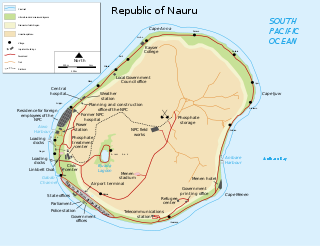
Nauru is a tiny phosphate rock island nation located in the South Pacific Ocean south of the Marshall Islands in Oceania. It is only 53 kilometres (33 mi) south of the Equator at coordinates 0°32′S166°55′E. Nauru is one of the three great phosphate rock islands in the Pacific Ocean—the others are Banaba in Kiribati and Makatea in French Polynesia.
Volcanism, vulcanism, volcanicity, or volcanic activity is the phenomenon where solids, liquids, gases, and their mixtures erupt to the surface of a solid-surface astronomical body such as a planet or a moon. It is caused by the presence of a heat source, usually internally generated, inside the body; the heat is generated by various processes, such as radioactive decay or tidal heating. This heat partially melts solid material in the body or turns material into gas. The mobilized material rises through the body's interior and may break through the solid surface.

An evaporite is a water-soluble sedimentary mineral deposit that results from concentration and crystallization by evaporation from an aqueous solution. There are two types of evaporite deposits: marine, which can also be described as ocean deposits, and non-marine, which are found in standing bodies of water such as lakes. Evaporites are considered sedimentary rocks and are formed by chemical sediments.

An underwater environment is a environment of, and immersed in, liquid water in a natural or artificial feature, such as an ocean, sea, lake, pond, reservoir, river, canal, or aquifer. Some characteristics of the underwater environment are universal, but many depend on the local situation.

Dungeon Keeper is a strategy video game developed by Bullfrog Productions and released by Electronic Arts in June 1997 for MS-DOS and Windows 95. In Dungeon Keeper, the player builds and manages a dungeon, protecting it from invading 'hero' characters intent on stealing accumulated treasures, killing monsters and ultimately the player's demise. The ultimate goal is to conquer the world by destroying the heroic forces and rival dungeon keepers in each realm. A character known as the Avatar appears as the final hero. Dungeon Keeper uses Creative Technology's SoundFont technology to enhance its atmosphere. Multiplayer with up to four players is supported using a modem, or over a local network.

Radiata Stories is an action role-playing video game. It was developed by tri-Ace and published by Square Enix for the PlayStation 2. It was released on January 27, 2005 in Japan and September 6 in North America.

"Dagon" is a short story by American author H. P. Lovecraft. It was written in July 1917 and is one of the first stories that Lovecraft wrote as an adult. It was first published in the November 1919 edition of The Vagrant. Dagon was later published in Weird Tales in October 1923. It is considered by many to be one of Lovecraft's most forward-looking stories.

Marine engineering is the engineering of boats, ships, submarines, and any other marine vessel. Here it is also taken to include the engineering of other ocean systems and structures – referred to in certain academic and professional circles as "ocean engineering". After completing this degree one can join a ship as an officer in engine department and eventually rise to the rank of a chief engineer. This rank is one of the top ranks onboard and is equal to the rank of a ship's captain. Marine engineering is the highly preferred course to join merchant Navy as an officer as it provides ample opportunities in terms of both onboard and onshore jobs.
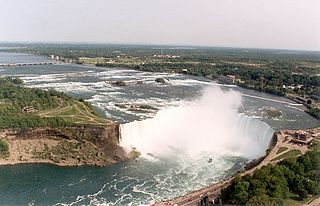
In geomorphology, a knickpoint or nickpoint is part of a river or channel where there is a sharp change in channel bed slope, such as a waterfall or lake. Knickpoints reflect different conditions and processes on the river, often caused by previous erosion due to glaciation or variance in lithology. In the cycle of erosion model, knickpoints advance one cycle upstream, or inland, replacing an older cycle. A knickpoint that occurs at the head of a channel is called a headcut. Headcuts resulting in headward erosion are hallmarks of unstable expanding drainage features such as actively eroding gullies.

References to the fictional kraken are found in film, literature, television, and other popular culture forms.

Compatibility is a term used by geochemists to describe how elements partition themselves in the solid and melt within Earth's mantle. In geochemistry, compatibility is a measure of how readily a particular trace element substitutes for a major element within a mineral.
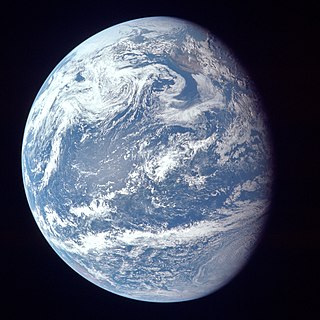
An ocean world, ocean planet or water world is a type of planet or natural satellite that contains a substantial amount of water in the form of oceans, as part of its hydrosphere, either beneath the surface, as subsurface oceans, or on the surface, potentially submerging all dry land. The term ocean world is also used sometimes for astronomical bodies with an ocean composed of a different fluid or thalassogen, such as lava, ammonia or hydrocarbons. The study of extraterrestrial oceans is referred to as planetary oceanography.
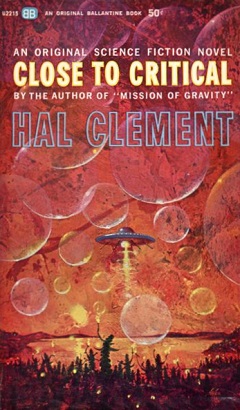
Close to Critical is a science fiction novel by American writer Hal Clement. The novel was first serialized in three parts and published in Astounding Science Fiction magazine in 1958. Its first hardcover book publication was in July 1964.
Extraterrestrial liquid water is water in its liquid state that naturally occurs outside Earth. It is a subject of wide interest because it is recognized as one of the key prerequisites for life as we know it and is thus surmised to be essential for extraterrestrial life.

The Gill-man—commonly called the Creature—is the main antagonist of the 1954 black-and-white science fiction film Creature from the Black Lagoon and its two sequels Revenge of the Creature (1955) and The Creature Walks Among Us (1956).

A river is a natural freshwater stream that flows on land or inside caves towards another body of water at a lower elevation, such as an ocean, lake, or another river. A river may run dry before reaching the end of its course if it runs out of water, or only flow during certain seasons. Rivers are regulated by the water cycle, the processes by which water moves around the Earth. Water first enters rivers through precipitation, whether from rainfall, the runoff of water down a slope, the melting of glaciers or snow, or seepage from aquifers beneath the surface of the Earth.
Left 4 Dead is a series of cooperative first-person shooter survival horror video games created by Turtle Rock Studios and published by Valve. Set in the days after a pandemic outbreak of a viral strain transforming people into zombie-like feral creatures, the games follow the adventures of four survivors attempting to reach safe houses and military rescue while fending off the attacking hordes.

"In the Abyss" is a short story by English writer H. G. Wells, first published in 1896 in Pearson's Magazine. It was included in The Plattner Story and Others, a collection of short stories by Wells first published in 1897. The story describes a journey to the ocean bed in a specially-designed metal sphere; the explorer within discovers a civilization of human-like creatures.
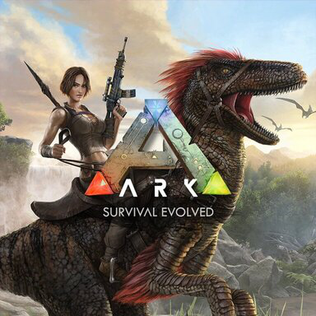
Ark: Survival Evolved is a 2017 action-adventure survival video game developed by Studio Wildcard. In the game, players must survive being stranded on one of several maps filled with roaming dinosaurs, fictional fantasy monsters, and other prehistoric animals, natural hazards, and potentially hostile human players.















